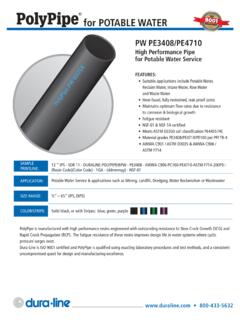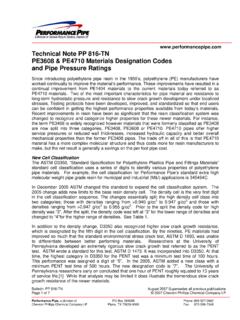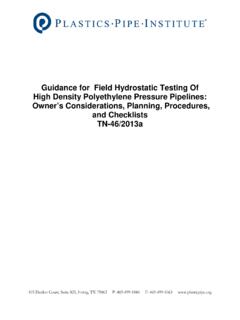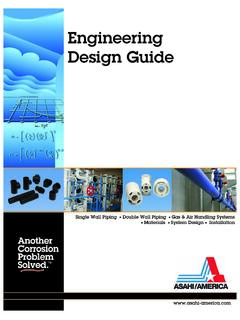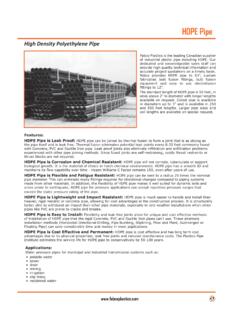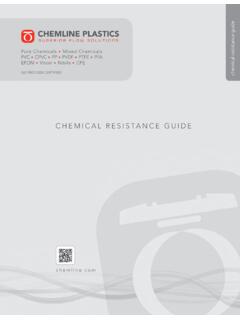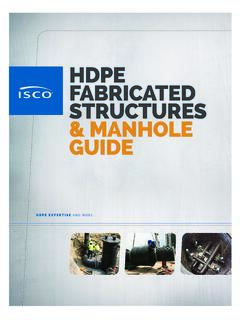Transcription of Poly Pipe Socket and Butt Fusion Manual - Hdpe Supply
1 HEAT Fusion JOINING PROCEDURESTABLE OF CONTENTS FEDERAL REGULATIONS ..1 HEAT Fusion ..2 INCLEMENT WEATHER ..3 NOTES ON Fusion CONFIDENCE ..3 Fusion CHECKLIST ..4 butt Fusion ..5 Procedure ..6 Qualification ..10 SADDLE Fusion ..15 Definitions ..15 Procedure ..17 Qualification ..18 Socket Fusion ..22 Equipment Requirements ..22 Heater Temperature ..22 Procedure ..23 Qualification ..25 APPENDIX A ..29 Hydraulic Fusion Machine Gauge Pressure ..29 REFERENCES ..30 FIGURES FIGURE I butt Fusion Bent Strap Test Specimen ..10 FIGURE II Saddle Fusion Bent Strap Test Specimen ..18 FIGURE III Socket Fusion Bent Strap Test Specimen ..25 TABLES TABLE I butt Fusion : Approximate Melt Bead Size ..7 TABLE II butt Fusion : Maximum Heater Plate Removal Time ..8 TABLE III butt Fusion : Bead Widths Per Wall Thickness.
2 9 TABLE IV butt Fusion : Troubleshooting Guide ..14 TABLE V Saddle Fusion : Maximum Heating/Minimum Cooling Times ..16 TABLE VI Saddle Fusion : Troubleshooting Guide ..21 TABLE VII Socket Fusion : Time Cycles ..24 TABLE VIII Socket Fusion : Troubleshooting Guide ..28 The statements and technical data given in this brochure were developed on the basis of conservative test measures and are believed to be accurate. The information is meant to serve only as a general guide; and the operator and/or any individual user must verify the specific parameters of each application for their intended use and specific system. Due to wide variations in service conditions, installation techniques, field conditions, weather conditions, and other factors, NO WARRANTY OR GUARANTEE, EXPRESS OR IMPLIED, IS GIVEN IN CONJUNCTION WITH THE USE OF THESE addition, this procedure does not purport to address all of the safety concerns, if any, associated with its use.
3 It is the responsibility of the user of this procedure to establish any and all appropriate safety and health practices and to determine the applicability of regulatory requirements prior to integral part of any pipe system is the method used to join the system components. Proper engineering design of a system will take into consideration the type and effectiveness of the techniques used to join the pipe and appurtenances, as well as the durability of the resulting joints. The integrity and versatility of the joining techniques used for polyethylene (PE) pipe allow the designer to take advantage of the performance benefits of PE in a wide variety of applications. There are three types of heat Fusion joints currently used in the industry: butt , saddle and Socket Fusion . Additionally, there are two methods for producing the Socket and saddle Fusion joints.
4 In addition to the Fusion procedures that follow, electrofusion is recognized as an acceptable method of producing Socket and saddle fusions but is not addressed in this document. The user of electrofusion products should contact the provider of those products for details on use in joining pipe . The Fusion procedures that follow have been proven to consistently produce sound Fusion joints in bench trials when used correctly and are recommended for the joining of PolyPipe products. The recommended procedures for butt and saddle fusions are consistent with the Plastics pipe Institute (PPI) Technical Reports (TR) TR-33, Generic butt Fusion Procedures and TR-41, Generic Saddle Fusion REGULATIONSF ederal regulations require that all operators qualify both their joining procedures and the personnel installing pipe .
5 The Pipeline Safety Regulations, issued by the Department of Transportation (DOT) Pipeline and Hazardous Materials Safety Administration, are found at 49 CFR Part 192. Pursuant to 49 CFR (a), an operator is required to qualify heat Fusion joining procedures before the procedure is used in the field. Further, 49 CFR Part requires that an operator qualify the personnel who will be making heat Fusion joints in the field. Additional Federal regulations may apply, and State regulations that are corollaries to the Pipeline Safety Regulations also apply, as may additional, more stringent, state operator is responsible for ensuring that all aspects of their Fusion joining processes and procedures are in compliance with the requirements of 49 CFR, Part 192 and ASTM regulations require that all operators qualify both their joining procedures and the personnel installing pipe .
6 The Pipeline Safety Regulations, issued by the Department of Transportation (DOT) Pipeline and Hazardous Materials Safety Administration, are found at 49 CFR Part 192. Pursuant to 49 CFR (a), an operator is required to qualify heat Fusion joining procedures before the procedure is used in the field. Further, 49 CFR Part requires that an operator qualify the personnel who will be making heat Fusion joints in the field. Additional Federal regulations may apply, and State regulations that are corollaries to the Pipeline Safety Regulations also apply, as may additional, more stringent, state operator is responsible for ensuring that all aspects of their Fusion joining processes and procedures are in compliance with the requirements of 49 CFR, Part 192 and ASTM PRODUCTS GAS DISTRIBUTION/OILFIELD M&I, WATER AND SPECIALTY PolyPipe PolyTough1TM PolyPipe EHMW PLUS PolyPipe GDY20 PolyPipe POLYPLUS PolyPipe GDB50/GB50 PolypipE LIGHTVIEW PLUSTM POLYPIPE ENVIROPIPE TM1 HEAT FUSIONThe principle behind heat Fusion is to heat two surfaces to a designated temperature, and then fuse them together by application of the required force.
7 This applied force joins the melted surfaces resulting in a permanent, monolithic Fusion joint. PolyPipe Fusion procedures require specific tools and equipment for the Fusion type and for the sizes of pipe and fittings to be Fusion This technique consists of heating the squared ends of two pipes, a pipe and fitting, or two fittings by holding them against a heated plate, removing the plate when the proper melt is obtained, promptly bringing the ends together and allowing the joint to cool while maintaining the appropriate applied Fusion This technique involves melting the concave surface of the base of a saddle fitting, while simultaneously melting a matching pattern on the surface of the pipe , bringing the two melted surfaces together and allowing the joint to cool while maintaining the appropriate applied Fusion This technique involves simultaneously heating the outside surface of a pipe end and the inside surface of a fitting Socket , which is sized to be smaller than the smallest outside diameter of the pipe .
8 After the proper melt has been generated at each face to be mated, the two components are joined by inserting the pipe into the fitting. The Fusion is formed at the interface resulting from the interference fit. The melts from the two components flow together and fuse as the joint cools. Properly fused PE joints do not leak. If a leak is detected during pneumatic or hydrostatic testing, it is possible for a system failure to occur. Caution should be exercised in approaching a pressurized pipeline and any attempts to correct the leak should not be made until the system has been depressurized. Note: PE cannot be joined by solvent bonding or threading. Extrusion welding or hot air welding is not recommended for pressure applications. butt FusionSaddle FusionSocket Fusion2 INCLEMENT WEATHERPE has reduced impact resistance in sub-freezing conditions.
9 Additional care should be exercised while handling in sub-freezing conditions. In addition, PE pipe will be harder to bend and/or uncoil. For recommended guidelines when fusing in inclement weather, refer to the Plastics pipe Institute, PPI, Technical Note TN-42: Recommended Minimum Training Guidelines for PE pipe butt Fusion Joining Operators for Municipal and Industrial Projects. These guidelines apply to all information concerning cold weather procedures is available in ASTM F2620, Standard Practice for Heat Fusion Joining of Polyolefin pipe and Fittings, Annex A1. The operator should ensure that its qualified Fusion procedures take into account and are adapted for all potential inclement weather conditions in which the operator may be fusing polyethylene ON Fusion CONFIDENCER eliable Fusion joints of PE piping systems can be accomplished under reasonable latitude of conditions.
10 The operator should qualify its own procedures for every condition under which it will be fusing polyethylene pipe . Additionally, the operator should qualify all personnel who will responsible for performing fusions of polyethylene pipe . The following is a listing of general notes to help ensure proper equipment and techniques are utilized:1. The Fusion operator must have adequate training and understanding of the equipment and tools and the Fusion understanding of the operation of the equipment and tools can produce a Fusion of poor quality. The operator must understand thoroughly how to use the equipment and tools, their function and operation. The operator should adhere to the equipment manufacturer s instructions. Fusion pressures and heating/cooling cycles may vary dramatically according to pipe size and wall thickness.


